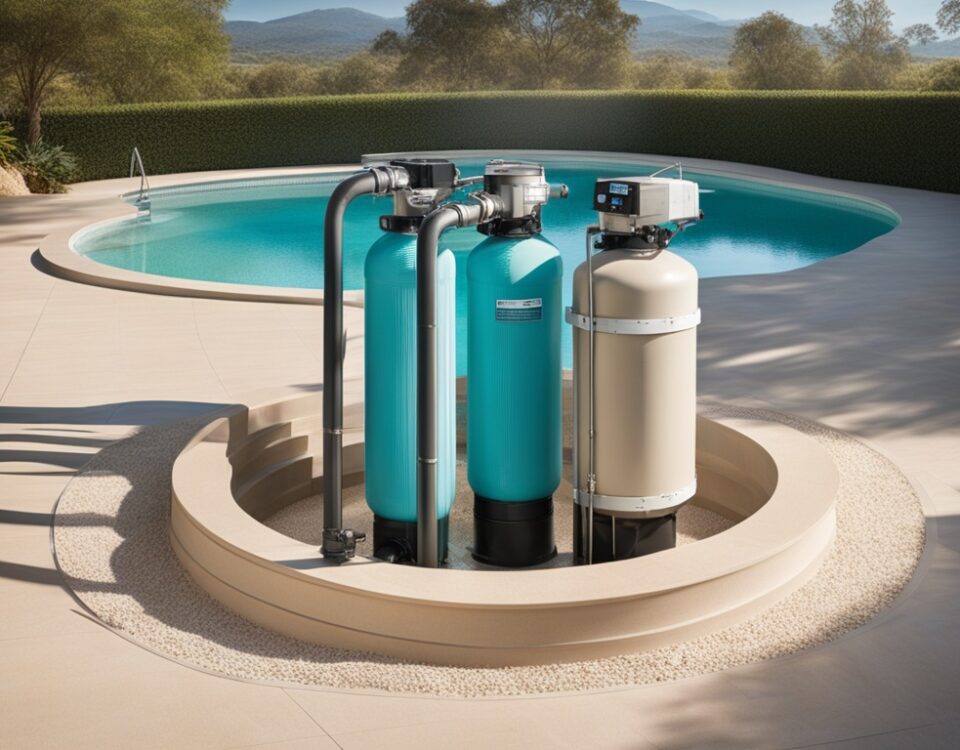Unveiling the Magic: Demystifying How a Saltwater Chlorinator Works

Suction Cleaner or Pool Skimmer: Which Reigns Supreme for Sparkling Pools?
May 7, 2025
The Ultimate Showdown: Steel vs Polymer Pool Walls – Unveiling the Best Choice
May 7, 2025Understanding the Basics of Saltwater Chlorinators
Saltwater chlorinators represent a sophisticated method of maintaining cleanliness and safety in swimming pools, utilizing the natural properties of salt to generate chlorine. This process unfolds through electrolysis, a chemical reaction initiated when salt (sodium chloride) is dissolved in water and passed through an *electrolytic cell*. Here, electrical currents convert the salt into free chlorine, which effectively sanitizes the water, eliminating harmful bacteria, algae, and other contaminants that may compromise water quality.
The Electrolysis Process
The fundamental operation of a saltwater chlorinator begins with a relatively low concentration of salt in the pool water, typically ranging from 2,500 to 4,000 parts per million. This allows the chlorinator to transform the dissolved salt into *hypochlorous acid*, the active form of chlorine that exhibits powerful disinfectant properties. As water circulates through the chlorinator, it is drawn into the electrolytic cell where the formation of chlorine occurs—an elegant and efficient cycle that serves to continuously replenish the pool’s sanitation levels.
Advantages of Saltwater Systems
One of the most compelling advantages of employing a saltwater chlorinator is reduced chemical usage, which translates into *lower maintenance costs* over time. Unlike traditional chlorine pools, which require constant manual addition of chlorine tablets or liquid, saltwater systems autonomously generate chlorine as needed. This not only simplifies upkeep but also minimizes skin and eye irritation, making for a more pleasurable swimming experience for users who are sensitive to chlorine levels.
The Role of Chlorination in Pool Maintenance
Chlorination plays an instrumental role in maintaining a clean swimming pool, chiefly by preventing the proliferation of harmful microorganisms. Understanding that chlorine works through a mechanism of oxidation, it effectively breaks down organic matter that might otherwise lead to murky water and unpleasant odors. Thus, *consistent chlorination* helps to achieve crystal-clear water and prolongs the life of pool infrastructure by mitigating potential damage from pathogens and algae.
Monitoring Salt Levels
In a saltwater system, it is vital to regularly monitor the salinity levels to ensure optimal performance of the chlorinator. A well-balanced salt concentration not only guarantees adequate chlorine production but also protects the integrity of the pool equipment. For this purpose, many modern systems are equipped with automatic sensors that provide real-time readings and alerts, enabling pool owners to maintain their pools without the constant worry of manual testing.
Environmental Considerations
In addition to operational benefits, saltwater chlorinators offer *environmental advantages*, as they reduce chemical runoff associated with traditional chlorination methods. By leveraging the properties of salt, these systems contribute to sustainable pool management practices. Moreover, the reduced reliance on chemical deliveries minimizes packaging waste and lowers the carbon footprint associated with transporting pool sanitization supplies, embodying a greener approach to recreational water management.
The Science Behind Saltwater Chlorinators
Saltwater chlorinators employ a fascinating chemical process to maintain pristine pool conditions. At the heart of this innovation lies the *conversion of sodium chloride (table salt)* into chlorine, a pivotal element in ensuring the water remains free from harmful bacteria and algae. This seamless transformation is not merely a magical occurrence but rather the result of careful engineering and understanding of electrochemical principles.
The Role of Sodium Chloride
In a typical saltwater pool, *sodium chloride* is dissolved in the water, creating a saline solution that is both gentle on the skin and effective in water sanitation. The concentration of salt in these systems is significantly lower than that found in ocean water, usually around 3000 to 4000 parts per million (ppm). This lower salt level still enables the chlorinator to perform efficiently while providing a comfortable swimming experience.
Electrolysis: The Heart of Chlorination
The process that transforms salt into chlorine is known as *electrolysis*. This occurs within the chlorinator’s salt cell—an integral component that houses metal plates (anodes and cathodes). When electric current passes through these plates, a chemical reaction occurs, leading to the dissociation of salt molecules. Specifically, this process can be encapsulated in the chemical reaction:
| Reactants | Products |
|---|---|
| 2 NaCl + 2 H2O | Cl2 (gas) + H2 + 2 NaOH |
The electrolysis process yields *chlorine gas*, which either dissolves back into the pool water or combines with other molecules to produce hypochlorous acid—a potent disinfectant. This acid is responsible for killing microorganisms and ensuring that the water remains crystal clear and safe for swimmers.
Continuous Chlorine Generation
One of the remarkable features of saltwater chlorinators is their ability to continuously generate chlorine as long as the pool is operational. The chlorinator operates automatically, adjusting production based on the pool’s *sanitation needs* and environmental factors, such as temperature and sunlight exposure. This level of automation not only enhances convenience but also helps maintain optimal water chemistry effortlessly.
Benefits of Using Saltwater Chlorinators
The utilization of saltwater chlorinators offers numerous advantages over traditional chlorination methods. The production of chlorine through electrolysis lowers the need for handling harsh chemicals, which can pose safety risks. Furthermore, the *softer feel* of saltwater is often preferred by swimmers, minimizing skin irritation and eye redness associated with higher chlorine levels. This natural approach to pool maintenance promotes a *healthier and more enjoyable swimming experience*.
Components of a Saltwater Chlorinator System
Understanding the components of a saltwater chlorinator system is essential for pool owners who wish to maintain a pristine swimming environment. These systems leverage advanced technology to automate the chlorination process, providing a more efficient alternative to traditional chemical-based methods. Below, we delve into the key components that work harmoniously to keep your pool water clean and safe.
The Salt Cell
At the heart of a saltwater chlorinator system lies the salt cell, a pivotal component responsible for converting salt into chlorine through a process known as electrolysis. When saltwater passes through the salt cell, the electrodes generate an electric current that facilitates the conversion of sodium chloride. This transformation produces free chlorine, which actively sanitizes the pool water by eliminating harmful bacteria and algae. Regular maintenance, including cleaning the salt cell and monitoring its lifespan, is critical to ensure optimal performance and prevent scaling.
The Control Panel
The control panel serves as the command center of the saltwater chlorinator system, allowing users to customize settings and monitor the system’s performance. This user-friendly interface typically includes digital displays that provide vital information such as chlorine levels, water temperature, and system operational status. Many modern control panels are equipped with advanced features, including timers and pH control options, enabling automated adjustments based on real-time water chemistry assessments. This ensures that the pool maintains a consistent level of sanitization while minimizing manual intervention.
The Circulation System
The circulation system plays a crucial role in the efficacy of a saltwater chlorinator by ensuring uniform distribution of chlorine throughout the pool. This system typically comprises a pool pump, filter, and plumbing lines that work in conjunction to circulate water. The pool pump draws water from the pool, sends it through the filter to remove debris, and then directs it to the salt cell for chlorination. Proper maintenance of the circulation system is essential; a well-functioning circulation process guarantees that chlorine is evenly dispersed, enhancing water clarity and safety.
Other Essential Components
Aside from the primary components, there are several other critical elements within a saltwater chlorinator system that contribute to its overall functionality. These include:
| Component | Function |
|---|---|
| Salt | Serves as the base material for chlorine production. |
| Bypass Valve | Controls water flow through the salt cell for adjustments. |
| Flow Meter | Measures the flow rate of water passing through the system. |
Understanding these components will aid pool owners in making informed choices about their saltwater chlorination systems. Additionally, knowledge of each part’s function fosters a deeper appreciation for the technology at work in maintaining your pool’s cleanliness and safety.
Maintenance Considerations
To ensure the longevity and efficiency of the components within a saltwater chlorinator system, routine maintenance is imperative. Regularly inspecting the salt cell for buildup, checking the control panel for accurate readings, and ensuring that the circulation system remains unobstructed will enhance the overall effectiveness of the system. By allocating time for maintenance, pool owners can significantly reduce the likelihood of costly repairs and guarantee a consistently sparkling pool all season long.
Benefits of Using a Saltwater Chlorinator
Utilizing a saltwater chlorinator presents a myriad of advantages over traditional chlorine methods, enhancing both the functionality and enjoyment of your swimming pool. One of the most significant benefits is the reduction in the overall amount of harsh chemicals needed to maintain clean and clear water. Saltwater chlorinators produce chlorine as needed, eliminating the necessity for you to handle, store, and carefully manage unstable chlorine products.
Cost Efficiency
Investing in a saltwater chlorinator often leads to long-term financial savings. Although the initial installation cost may be higher than traditional systems, the operational costs are typically lower. Salt is less expensive than chlorine tablets or liquid, and with a saltwater system, you’ll find that your pool maintenance costs decrease over time. In fact, many pool owners report savings of up to 50% on chemical costs.
Improved Water Quality
Saltwater chlorinators offer enhanced water quality that many pool owners cherish. The chemical process of chlorination produces softer water that reduces skin and eye irritation, making swimming a much more pleasurable experience. With its ability to maintain stable chlorine levels, saltwater systems prevent the spikes in chlorine concentration common with manual dosing, thus ensuring a more consistent and safe swimming environment.
Comfortable Swimming Experience
One of the most compelling aspects of saltwater systems is their *superior comfort*. Swimming in a saltwater pool feels akin to being in a natural body of water; *the gentle saline solution is less abrasive to the skin and eyes*. This is particularly advantageous for families with children or individuals prone to sensitivity. Gone are the days of stinging eyes and dry skin—saltwater pools promote a soothing swimming experience that truly enhances your aquatic leisure.
Low Maintenance Requirements
Another remarkable benefit of saltwater chlorinators is their low maintenance requirements. These systems typically involve less frequent cleaning and chemical balancing compared to traditional pools. Thanks to their self-regulating ability, saltwater chlorinators continuously produce chlorine, preventing algae and bacteria growth without constant intervention from the pool owner. This means more time enjoying your pool and less time spent on upkeep.
Environmental Advantage
In today’s environmentally-conscious society, choosing a saltwater chlorinator can also be viewed as a *responsible choice*. Traditional chlorine pools often lead to the leaching of chemical runoff into the environment, which can pose risks to surrounding ecosystems. Saltwater systems utilize a more natural method of sanitation, thus minimizing the number of harsh chemicals that could potentially harm local wildlife or waterways.
Visual Appeal
Lastly, many pool enthusiasts appreciate the aesthetic qualities of saltwater pools. Their water often appears more *inviting*, with a clearer and more appealing surface that sparkles under sunlight. This not only enhances the visual appeal of your backyard oasis but also promotes a sense of tranquility as you unwind amidst nature.
| Benefit | Saltwater Chlorinator | Traditional Chlorine System |
|---|---|---|
| Initial Cost | Higher | Lower |
| Ongoing Costs | Lower (savings of up to 50%) | Higher |
| Water Comfort | Soothing and gentle | Can irritate skin and eyes |
| Maintenance | Low | High |
| Environmental Impact | Lower | Higher |
Maintenance Tips for Saltwater Chlorinators
Maintaining a saltwater chlorinator is essential for ensuring the longevity and efficiency of your swimming pool system. With proper upkeep, you can enjoy clean and safe swimming conditions without the hassles associated with traditional chlorine. Below are key maintenance tips to help you care for your saltwater chlorinator.
Regular Monitoring of Salt Levels
One of the most critical aspects of maintaining a saltwater chlorinator is keeping a close eye on the *salt levels* in your pool. Low salt levels can hinder the chlorinator’s ability to generate chlorine effectively, leading to imbalanced water chemistry. Ideal salt concentration should typically range between 2,500 to 4,000 parts per million (ppm). To keep your pool water balanced, regularly test the salt levels using a reliable saltwater test kit or test strips.
Cleaning the Salt Cell
The *salt cell*, also known as the chlorinator cell, is the heart of the saltwater chlorination system. It requires periodic cleaning to remove the calcium buildup that can accumulate over time. A *dirty salt cell* can significantly hinder chlorine production and may even lead to failure. It’s advisable to inspect and clean the salt cell every three to six months, or more frequently if you notice reduced chlorine output.
How to Clean the Salt Cell
To clean your salt cell, follow these steps:
- Turn off the power to the chlorinator and disconnect the salt cell.
- Prepare a cleaning solution using a mixture of one part muriatic acid and four parts water in a plastic container. Always add acid to water, not the other way around, to prevent dangerous reactions.
- Submerge the salt cell in the solution for about 10 to 15 minutes.
- Rinse the cell thoroughly with water to remove any remaining cleaning solution.
- Reattach the cell to the system and restore power.
Inspecting and Maintaining Other Components
In addition to monitoring salt levels and cleaning the salt cell, it’s crucial to regularly inspect other components of your *saltwater chlorinator system*. Check the wiring for any signs of damage, ensure that the power supply is functioning correctly, and verify that the flow rate is within the manufacturer’s recommended guidelines. Keeping your chlorinator in optimal condition requires diligence and attention to detail.
Consistent Pool Water Testing
In conjunction with maintaining the chlorinator, frequent water testing is indispensable. Regularly test your swimming pool water for pH levels, alkalinity, and stabilizer levels. Maintaining a balanced pool environment not only aids the chlorinator’s performance but also provides a pleasant and safe swimming experience, preventing issues such as algae growth and cloudy water.
Seasonal Maintenance Considerations
As seasons change, so too does the maintenance required for your saltwater chlorinator. During warmer months, *increased pool usage* may necessitate more frequent checks of both water chemistry and chlorinator performance. Conversely, in the cooler months, when the pool may be less active, ensure that your system retains efficiency and prepares for seasonal shifts. Always consult your manufacturer’s guidelines for seasonal maintenance recommendations specific to your model.
Common Issues and Troubleshooting Strategies
While saltwater chlorinators offer numerous advantages for pool maintenance, they are not immune to issues that may impact their performance. Understanding these common problems and implementing practical troubleshooting strategies can ensure that your chlorinator operates efficiently, providing crystal-clear water in your swimming pool.
Voltage Issues
One of the most prevalent troubles encountered with saltwater chlorinators is voltage problems. If the unit is not receiving adequate voltage, it may not produce chlorine as intended. Symptoms include erratic readings on the control panel or blinking indicator lights.
Solutions: Begin by inspecting the power supply. Ensure that the circuit breaker is not tripped and that all connections are secure. If necessary, use a multimeter to test the voltage at the chlorinator’s connections. If the voltage is less than the manufacturer’s specifications, consider hiring an electrician for repairs.
Low Chlorine Output
Low chlorine output is another common issue that can stem from various factors, such as insufficient salinity levels or a malfunctioning electrolytic cell. This condition can lead to cloudy water and potential algae growth.
Solutions: First, check the salinity level with a testing kit; it should typically be between 2700-3400 ppm (parts per million). If the salinity is low, add the appropriate amount of salt. Additionally, inspect the electrolytic cell for scale buildup or damage. Regular cleaning of the cell may prevent this issue. If problems persist, replacement of the cell may be required.
Water Balance Problems
Maintaining optimal water balance is crucial for the efficient functioning of a saltwater chlorinator. Imbalanced pH, alkalinity, or calcium hardness levels can hinder chlorine production and affect water quality.
Solutions: Regularly test your pool water using a reliable testing kit. Aim for a pH level of 7.4 to 7.6, total alkalinity between 80-120 ppm, and calcium hardness of 200-400 ppm. Adjust these levels using appropriate chemicals to restore balance.
Cell Scaling and Corrosion
Cell scaling is a frequent occurrence with saltwater chlorinators, often due to high calcium levels or improper water balance. Scaling can impede chlorine generation and reduce the lifespan of the electrolytic cell, while corrosion may arise from low pH or high salinity levels.
Solutions: To prevent scaling, schedule regular cleanings using a mixture of water and muriatic acid, or a specialized descaling solution. Additionally, ensure that the water chemistry remains within the recommended levels, especially the pH and calcium hardness.
Inadequate Water Flow
Inadequate water flow can significantly impact the efficiency of saltwater chlorinators. A low flow can be caused by clogged filters, blocked skimmer baskets, or damaged pump components. Symptoms include low chlorine production and inconsistent water clarity.
Solutions: Inspect and clean the pool filter and skimmer basket regularly. Check for any obstructions in the plumbing and ensure that the pump is working correctly. If there’s still an issue, inspect the valves for any malfunctions and consult a professional if necessary.
Indicator Light Malfunctions
Indicator lights on saltwater chlorinators serve as a visual guide for the unit’s operation status. If these lights are blinking or displaying error messages, it could signify a problem requiring immediate attention.
Solutions: Refer to the chlorinator’s user manual for specific error codes and possible solutions. Reset the unit by turning it off and then back on. If the issue persists, contact the manufacturer’s customer support for further assistance, as they may provide insights specific to your model.
Expert Recommendations and Best Practices
Optimize Chlorinator Performance
To enhance the efficiency of your *saltwater chlorinator*, it is crucial to ensure that the salinity levels in your pool water are maintained within the optimal range, typically between 2700 to 3200 ppm. Regularly testing your water using a reliable saltwater test kit will provide insights into the current salt concentration, allowing you to make the necessary adjustments. A well-calibrated sensor is indispensable for detecting discrepancies and ensuring your chlorinator operates at peak performance.
Routine Maintenance Practices
Conducting regular maintenance on your chlorinator will *prolong* its lifespan substantially. This includes cleaning the salt cell at least once every three months, depending on your pool’s usage and local environmental factors. Calcium buildup can impede the chlorinator’s function; therefore, using a mild acid solution to remove scale will help in maintaining optimal efficiency. Implementing a routine maintenance schedule will also prevent unforeseen breakdowns, saving both time and cost.
Adjusting Operating Time
Expert recommendations suggest fine-tuning the operating time of your chlorinator according to seasonal changes. During warmer months, when pool usage increases, it is advisable to *extend* the run time to effectively manage chlorine levels. Conversely, in cooler months, you can reduce the duration, as the water’s temperature can impact chlorine demand. Accepting these fluid adjustments can lead to more effective chlorination while conserving energy.
Monitor Pool Chemistry
Ensuring a balanced pool chemistry is essential not just for swimmer safety, but also for the functionality of your chlorinator. Regularly check pH levels, alkalinity, and stabilizer concentrations as these can influence chlorine efficiency. The ideal pH level should range from 7.2 to 7.8 for optimal chlorination. A well-balanced pool also prevents the formation of harmful contaminants that can challenge your chlorinator’s performance.
Install a Timer or Automation System
Maximizing the efficiency of your saltwater chlorinator can be achieved by integrating a timer or a pool automation system. These devices are designed to regulate the operating hours of the chlorinator in sync with the ecological demands of your pool environment. Such automation not only ensures *consistent* chlorine production but also enhances energy efficiency, significantly reducing operational costs over time.
Follow Manufacturer Guidelines
Finally, adhering to the specific recommendations provided by the *manufacturer* of your saltwater chlorinator can prevent premature system failure and ensure optimal performance. Instruction manuals typically contain important details regarding specific settings, operational practices, and maintenance routines tailored to your model. Familiarize yourself with these guidelines and consult the manufacturer’s support for any unique challenges you may encounter.
Learn more about Swimming Pool

Javier Morales is passionate about pool design, maintenance, and outdoor living. With years of hands-on experience, he offers practical tips, creative ideas, and expert insights to help readers make the most of their pool spaces. At Piscina Planet, Javier shares everything from seasonal care guides to the latest trends in pool innovation.




